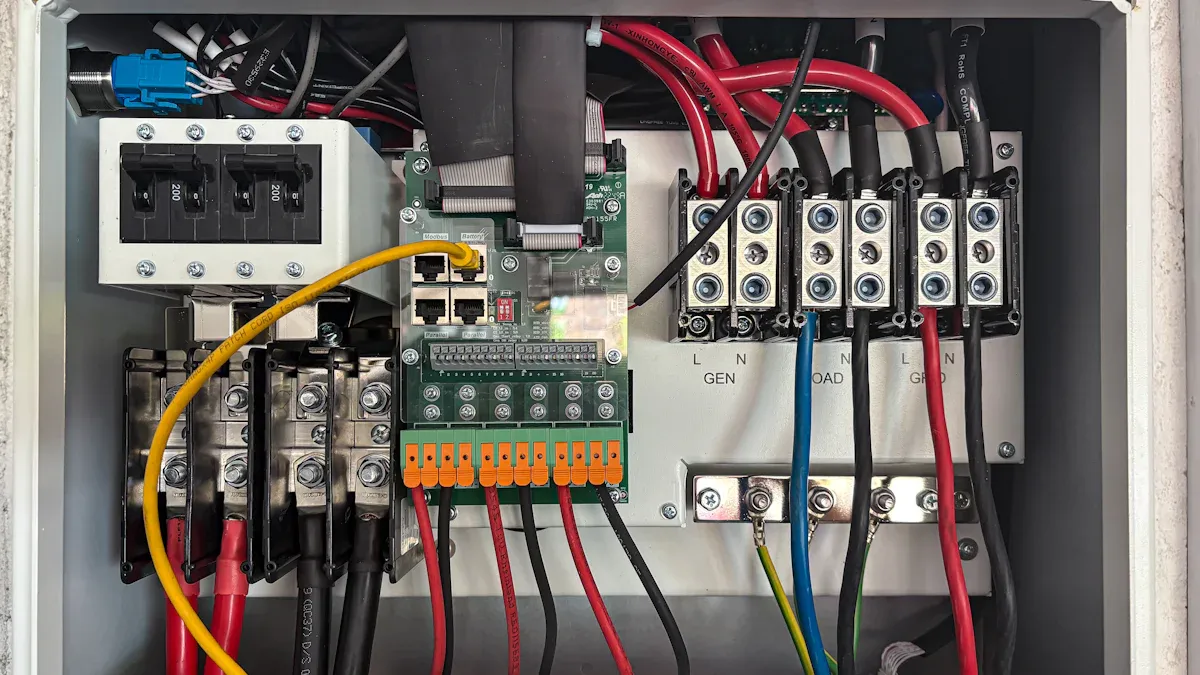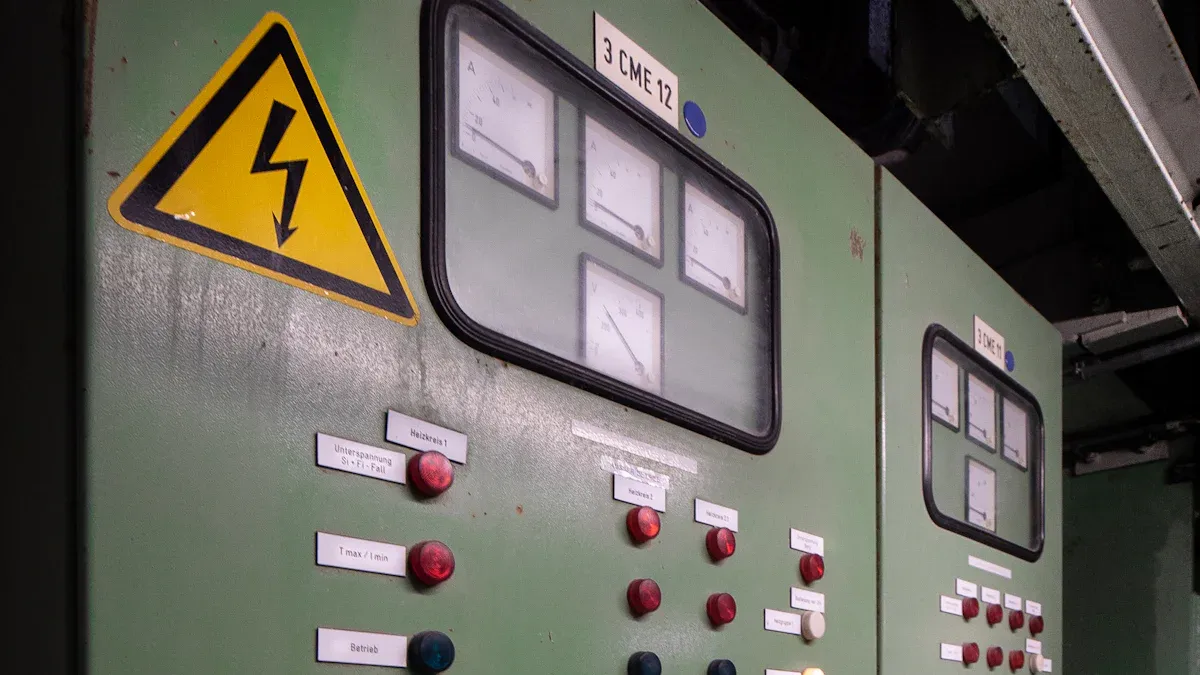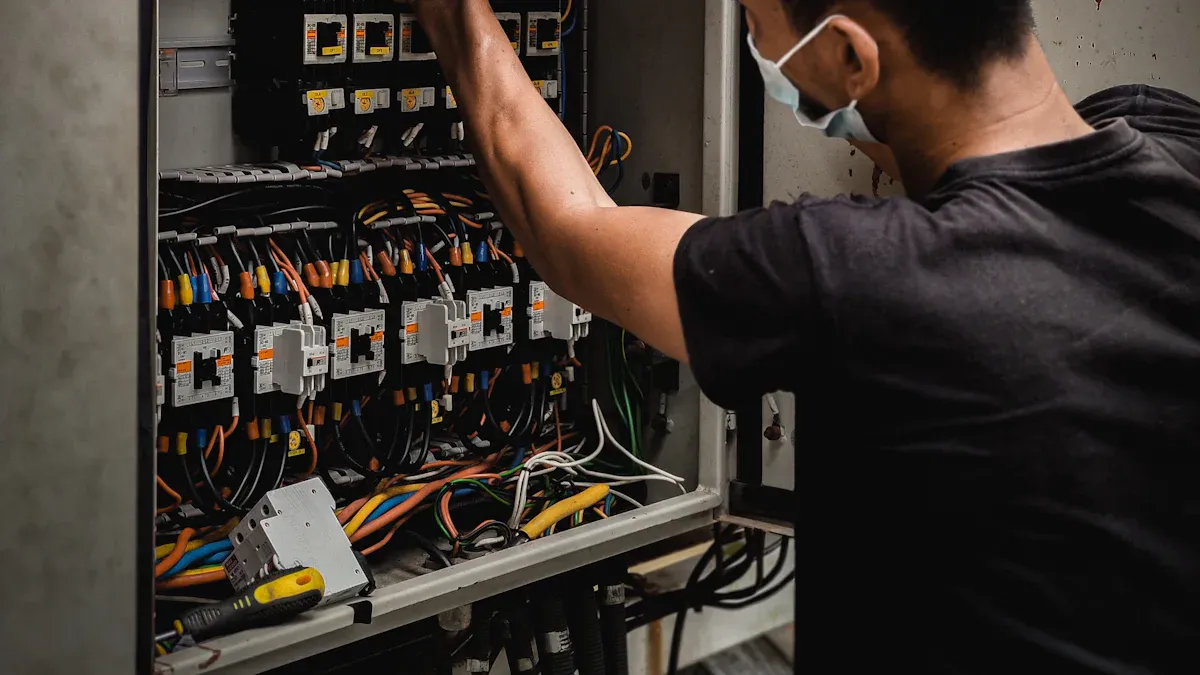ESTEL Low Voltage Cabinets in 2025 Applications

Modern electrical systems demand reliability, adaptability, and efficiency. You can meet these challenges with ESTEL low voltage distribution cabinets. Their advanced cooling systems optimize energy use, reducing waste and maintaining consistent performance. Modular designs allow you to customize configurations and expand systems as needs evolve. Sustainable materials ensure environmental responsibility while enhancing durability.
These cabinets also prioritize safety. Organized cable management improves operational efficiency and reduces hazards. Sensitive devices remain protected from environmental risks, ensuring uninterrupted power for critical operations. With scalable features and future-ready designs, ESTEL low-voltage solutions empower industries to embrace innovation confidently.
Key Takeaways
ESTEL low voltage cabinets save energy by using power better and cutting waste.
Their modular design makes them easy to change and grow for new business needs.
Safety features keep equipment safe and make workplaces safer with steady power.
Real-time checks and smart systems find problems early, reducing breaks and repair costs.
Using ESTEL cabinets gets your business ready for future tech while working better now.
Industrial Applications of Low Voltage Distribution Cabinets
Power Distribution in Manufacturing
You rely on efficient power distribution to keep manufacturing operations running smoothly. Low voltage distribution cabinets play a critical role in ensuring consistent and reliable power delivery. These cabinets regulate voltage levels, preventing equipment malfunctions and minimizing downtime. For instance, ESTEL low voltage cabinets offer advanced features like real-time monitoring and automation. These features allow you to track essential metrics, identify potential issues early, and maintain consistent performance across devices.
Metric | Benefit | Description |
|---|---|---|
Voltage Regulation | Improved operational efficiency | Ensures precise voltage control, preventing equipment malfunctions and enhancing reliability. |
Real-time Monitoring | Reduced maintenance costs | Tracks essential metrics, allowing for proactive issue identification and minimizing downtime. |
Automation | Consistent performance across devices | Automatically adjusts power supply to stabilize output, protecting sensitive equipment. |
High-quality Voltage Regulators | Extended lifespan of components and reduced risks of equipment failure | Delivers superior accuracy and durability, enhancing overall system performance. |
The growing demand for energy-efficient systems highlights the importance of these cabinets. The low voltage switch cabinet market, valued at $4.2 billion in 2023, is projected to reach $7.5 billion by 2032. This growth reflects the increasing reliance on low-voltage solutions in manufacturing environments.
Integration with Smart Factory Systems
Smart factories depend on seamless integration between power systems and digital technologies. Low voltage distribution cabinets enable this integration by providing modular and adaptable solutions. For example, the Modular Infrastructure Box supports flexible production by offering essential services like power, networking, and cybersecurity. It also facilitates fast data communication and ensures safety in manufacturing systems.
You can customize these cabinets to meet changing production needs. CHINT’s production lines demonstrate this adaptability by integrating industrial automation with SAP systems for automatic scheduling. This integration enhances precision and efficiency, allowing you to optimize manufacturing processes.
Tip: By incorporating low voltage cabinets into your smart factory systems, you can future-proof your operations and adapt to evolving technological demands.
Enhancing Safety and Reliability in Industrial Operations
Safety and reliability are non-negotiable in industrial settings. Low voltage distribution cabinets enhance both by protecting sensitive equipment and ensuring uninterrupted power supply. Organized cable management reduces hazards, while advanced cooling systems prevent overheating. These features create a safer working environment and extend the lifespan of your equipment.
Case studies further validate their effectiveness. ConEdison in New York City employs predictive maintenance strategies for its low-voltage distribution network. This approach prevents catastrophic power outages and ensures reliable operations. Similarly, I.M.E.S.A. successfully implemented ABB's Emax 2 low voltage air circuit-breakers in a marine environment. The compact switchgear solution handled high short-circuit breaking capacity, demonstrating the adaptability of low voltage cabinets in challenging conditions.
By investing in these cabinets, you not only enhance safety but also improve operational efficiency. Their robust design and advanced features make them indispensable for modern industrial applications.
Low Voltage Cabinets in Commercial Applications
Energy Management in Office Complexes
Efficient energy management is essential for modern office complexes. Low voltage distribution cabinets help you optimize energy use by regulating and distributing power effectively. These cabinets support smart grids and automation systems, enabling you to monitor and control energy consumption in real time. By reducing energy waste, they contribute to lower operational costs and a smaller carbon footprint.
The growing demand for energy-efficient solutions highlights the importance of these cabinets. The market for low voltage distribution cabinets is projected to reach USD 2.5 billion by 2024, with a compound annual growth rate (CAGR) of 6.2% from 2025 to 2030. Key drivers include advancements in automation, infrastructure modernization, and the transition to renewable energy.
Statistic | Value |
|---|---|
Market Size (2024) | USD 2.5 billion |
Projected CAGR (2025-2030) | 6.2% |
Key Drivers | Advancements in automation, demand for electrical equipment, smart grids, infrastructure modernization, renewable energy transition |
Supporting Renewable Energy in Commercial Spaces
Low-voltage cabinets play a vital role in integrating renewable energy into commercial spaces. These cabinets ensure reliable power distribution and protect electrical systems from overloads. They also provide the necessary control mechanisms to manage energy from solar panels, wind turbines, or hybrid systems.
The market for low-voltage switchgear cabinets continues to grow as industries prioritize energy efficiency and smart technologies. These cabinets are indispensable for renewable energy applications, offering the protection and reliability needed for seamless integration. As commercial spaces adopt renewable energy solutions, the demand for low-voltage cabinets will only increase.
Ensuring Electrical Safety in High-Occupancy Buildings
Safety is a top priority in high-occupancy buildings like shopping malls, hotels, and hospitals. Low voltage distribution cabinets enhance electrical safety by preventing short circuits and overloads. They also organize cables efficiently, reducing the risk of accidents.
Advanced features like real-time monitoring allow you to detect potential issues early, ensuring uninterrupted power supply. By investing in these cabinets, you can create a safer environment for occupants while maintaining reliable electrical performance. Their robust design and adaptability make them ideal for high-occupancy applications.
Low-Voltage Switchgear in Renewable Energy Systems

Power Distribution for Solar Farms
Solar farms rely on efficient power distribution to maximize energy output. Low-voltage switchgear plays a critical role in managing this distribution. It ensures that electricity generated by solar panels flows seamlessly into the grid or storage systems. By regulating voltage levels, it prevents energy losses and protects equipment from damage.
Modern low-voltage switchgear includes smart meters and sensors. These components allow you to monitor energy production in real time. They also help balance supply and demand, reducing waste and improving overall efficiency. For example, utilities can use automated fault detection to identify and resolve issues quickly, ensuring uninterrupted energy flow.
The growing adoption of solar energy highlights the importance of these systems. The low-voltage switchgear market is projected to grow from $31.76 billion in 2024 to $34.26 billion in 2025, with a CAGR of 7.9%. By 2029, the market size is expected to reach $44.54 billion. This growth reflects the increasing demand for renewable energy solutions and the critical role of low-voltage switchgear in supporting them.
Note: By investing in advanced switchgear, you can enhance the efficiency and reliability of solar farms, contributing to a sustainable energy future.
Supporting Wind Energy Infrastructure
Wind energy systems depend on reliable electrical components to handle variable power output. Low-voltage switchgear ensures stable energy distribution from wind turbines to the grid. It also protects the system from overloads and short circuits, which can occur due to fluctuating wind speeds.
One of the main components of low-voltage switchgear is the circuit breaker. It disconnects faulty sections of the system, preventing damage and ensuring safety. Additionally, remote-controlled operations allow you to manage wind energy systems efficiently, even in remote locations.
The benefits of low-voltage switchgear extend beyond safety. These systems facilitate seamless integration of wind turbines into the grid. They also enhance compatibility with distributed energy resources, making it easier to scale up wind energy projects. As renewable energy's contribution to power generation is expected to nearly triple from 21% in 2021 to 44% in 2050, the application of low-voltage switchgear in wind energy infrastructure will become even more critical.
Enabling Hybrid Energy Storage Solutions
Hybrid energy storage systems combine multiple energy sources, such as solar and wind, with battery storage. Low-voltage switchgear is essential for managing these complex systems. It regulates energy flow between sources and storage units, ensuring optimal performance.
Smart load management is one of the main components of low-voltage switchgear in hybrid systems. It balances supply and demand efficiently, reducing energy waste. Automated fault detection enhances grid stability by minimizing outages. These features make hybrid energy storage solutions more reliable and efficient.
Modern switchgear systems also support remote monitoring and control. This capability reduces the need for manual interventions, saving time and resources. By enabling seamless integration of renewable energy sources, low-voltage switchgear contributes to meeting sustainability goals.
Callout: Investing in advanced switchgear technology can help you optimize hybrid energy storage systems, ensuring a stable and reliable energy supply.
Applications in Data Centers

Ensuring Uninterrupted Power Supply
In data centers, maintaining an uninterrupted power supply is critical. Low-voltage cabinets play a vital role in ensuring consistent power delivery to servers and other essential equipment. These cabinets regulate voltage levels, protecting sensitive devices from fluctuations and outages. By incorporating advanced monitoring systems, they allow you to detect potential issues early and take preventive measures. This proactive approach minimizes downtime and ensures seamless operations.
Modern low-voltage solutions also support redundancy, which is essential for data centers. Redundant systems provide backup power during failures, ensuring continuous operation. For example, pre-engineered low-voltage cabinets can integrate with uninterruptible power supply (UPS) systems, enhancing reliability. This makes them indispensable for applications where even a brief power interruption can lead to significant losses.
Scalable Solutions for Growing Data Demands
As data centers expand, scalability becomes a top priority. Low-voltage cabinets offer modular designs that adapt to growing demands. You can start with smaller configurations and scale up as needed, reducing upfront costs and optimizing resource utilization. Prefabricated systems further enhance scalability by enabling faster deployment of additional capacity.
Metric | Description |
|---|---|
Density | Modular solutions can achieve densities of 20 kilowatts per cabinet or more. |
PUE | Pre-engineered modules can have PUE values as low as 1.1 – 1.4, indicating high energy efficiency. |
Modular Design | Smaller blocks allow for phased openings, reducing upfront investment and accelerating revenue generation. |
Prefabricated Systems | Standardized systems enable faster deployment of capacity, enhancing adaptability to growing demands. |
Capacity utilization is another critical metric for scalability. A low utilization ratio indicates inefficiencies, while a high ratio signals the need for additional resources. By investing in scalable low-voltage cabinets, you can address these challenges effectively and ensure your data center remains future-ready.
Improving Energy Efficiency in Critical Environments
Energy efficiency is a key concern for data centers due to their high energy consumption. Low-voltage cabinets contribute to efficiency by optimizing power distribution and minimizing energy losses. Features like real-time monitoring and smart load management help you track energy usage and identify areas for improvement.
Pre-engineered low-voltage systems also achieve impressive power usage effectiveness (PUE) values, ranging from 1.1 to 1.4. This metric reflects the efficiency of energy use within the data center. By adopting these solutions, you can reduce operational costs and lower your environmental impact.
Additionally, advanced cooling systems integrated into low-voltage cabinets prevent overheating, further enhancing energy efficiency. These features make them an ideal application for critical environments like data centers, where reliability and sustainability are paramount.
Public Infrastructure and Low Voltage Distribution Cabinets
Powering Transportation Systems
Modern transportation systems rely on efficient and reliable power distribution. Low-voltage cabinets play a crucial role in powering railways, subways, and electric vehicle (EV) charging stations. These cabinets ensure stable energy flow, preventing disruptions that could halt operations. For example, in rail systems, they regulate voltage levels to power signaling equipment, lighting, and communication networks.
You can also use low-voltage cabinets to support EV infrastructure. They distribute power to charging stations, ensuring consistent performance even during peak usage. Advanced features like real-time monitoring allow you to track energy consumption and optimize power delivery. This ensures that transportation systems remain operational and energy-efficient.
Supporting Smart City Initiatives
Smart cities depend on interconnected systems to manage resources efficiently. Low-voltage cabinets serve as the backbone of these systems by enabling seamless power distribution. They support applications like smart lighting, traffic management, and public Wi-Fi networks.
For instance, smart lighting systems use sensors to adjust brightness based on traffic or weather conditions. Low-voltage cabinets distribute power to these systems, ensuring they operate efficiently. Additionally, they integrate with renewable energy sources like solar panels, reducing the city's carbon footprint. By adopting these cabinets, you can enhance the sustainability and functionality of urban infrastructure.
Reliable Power for Healthcare Facilities
Healthcare facilities require uninterrupted power to support critical operations. Low-voltage cabinets ensure reliable energy distribution to essential systems. These include medical lighting, clinical gas and suction systems, and intercommunication networks. Prefabricated power modules and isolation transformers further enhance reliability by providing stable, ungrounded power sources.
You can also use low-voltage cabinets to monitor and maintain power quality. Features like line isolation monitors and ground integrity meters detect issues early, preventing equipment failures. This ensures that patient care remains unaffected, even during power fluctuations. By investing in these systems, you can create a safer and more efficient healthcare environment.
ESTEL Low Voltage Cabinets stand out as a versatile solution for modern electrical needs. You benefit from their ability to enhance energy efficiency, ensure safety, and support innovative technologies. These cabinets adapt seamlessly to diverse applications, from industrial operations to renewable energy systems.
Key Takeaway: By investing in ESTEL Low Voltage Cabinets, you prepare for future technological advancements while optimizing current operations. Their modular designs and advanced features make them a reliable choice for evolving energy demands.
With ESTEL, you can confidently embrace a sustainable and efficient future.
FAQ
What are low voltage cabinets used for?
Low voltage cabinets distribute and regulate electrical power in various applications. You can use them in industries, commercial spaces, renewable energy systems, and public infrastructure. They ensure safety, improve energy efficiency, and support modern technologies like smart grids and automation.
How do low voltage cabinets enhance safety?
These cabinets protect equipment from overloads and short circuits. Organized cable management reduces hazards, while advanced cooling systems prevent overheating. Real-time monitoring features allow you to detect issues early, ensuring a safer environment for both equipment and personnel.
Can low voltage cabinets support renewable energy systems?
Yes, they play a critical role in renewable energy applications. Low voltage cabinets manage energy flow from solar panels, wind turbines, and hybrid systems. They ensure stable power distribution, protect equipment, and integrate seamlessly with renewable energy sources to optimize performance.
Are low voltage cabinets scalable for future needs?
Absolutely! Modular designs make these cabinets highly scalable. You can start with a smaller setup and expand as your needs grow. Prefabricated systems also allow for quick deployment, making them ideal for industries and data centers with evolving energy demands.
Why should you invest in ESTEL low voltage cabinets?
ESTEL cabinets offer advanced features like real-time monitoring, modular designs, and superior safety mechanisms. They adapt to diverse applications, ensuring reliability and efficiency. By investing in ESTEL, you prepare for future technological advancements while optimizing current operations.
Tip: Choose ESTEL low voltage cabinets to future-proof your energy systems and enhance operational efficiency.
See Also
Ensuring Optimal Voltage Levels in Communication Cabinets by ESTEL
Innovative Outdoor Communication Cabinets Designed for Sustainability in 2025
Key Design Specifications for ESTEL's Outdoor Communication Cabinets
Benefits of ESTEL Cooling Solutions for Industrial Cabinet Use
CALL US DIRECTLY
86-13752765943
3A-8, SHUIWAN 1979 SQUARE (PHASE II), NO.111, TAIZI ROAD,SHUIWAN COMMUNITY, ZHAOSHANG STREET, NANSHAN DISTRICT, SHENZHEN, GUANGDONG, CHINA


